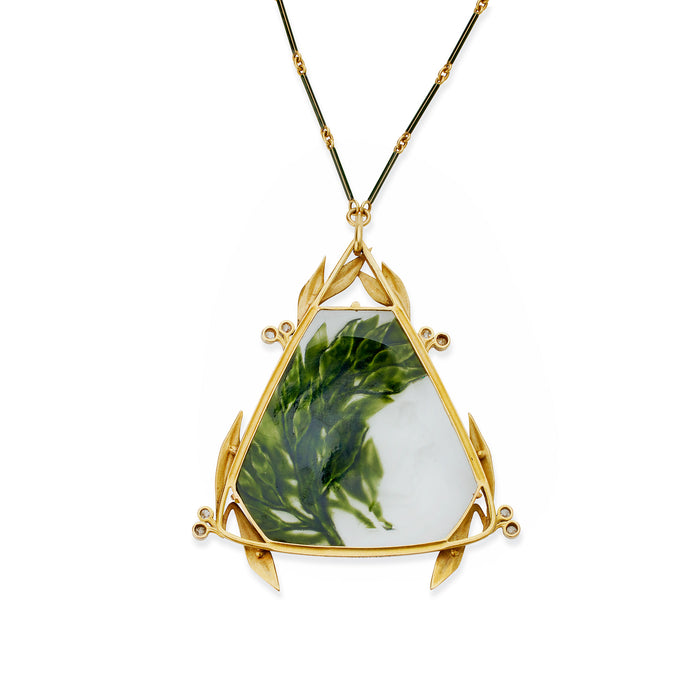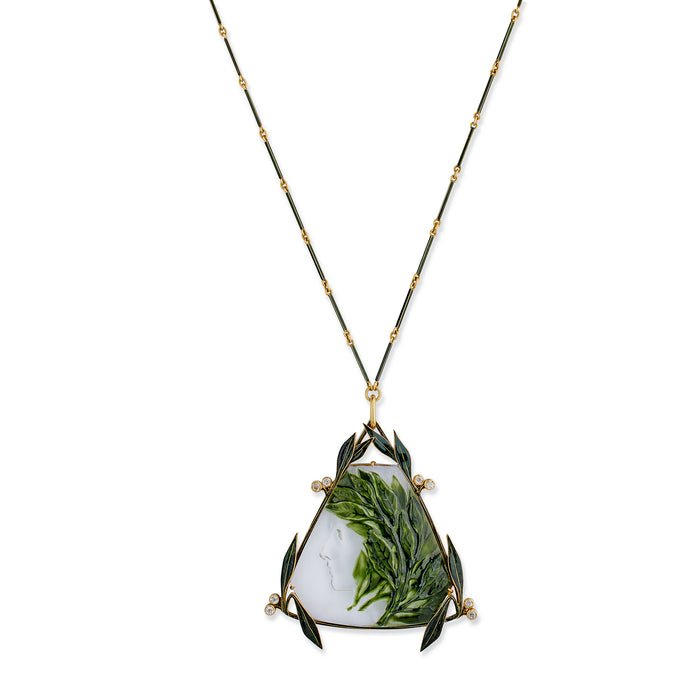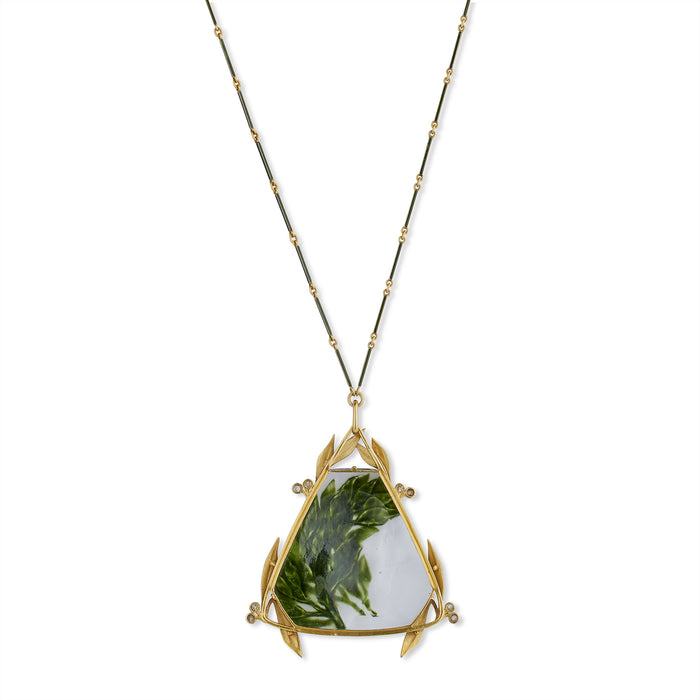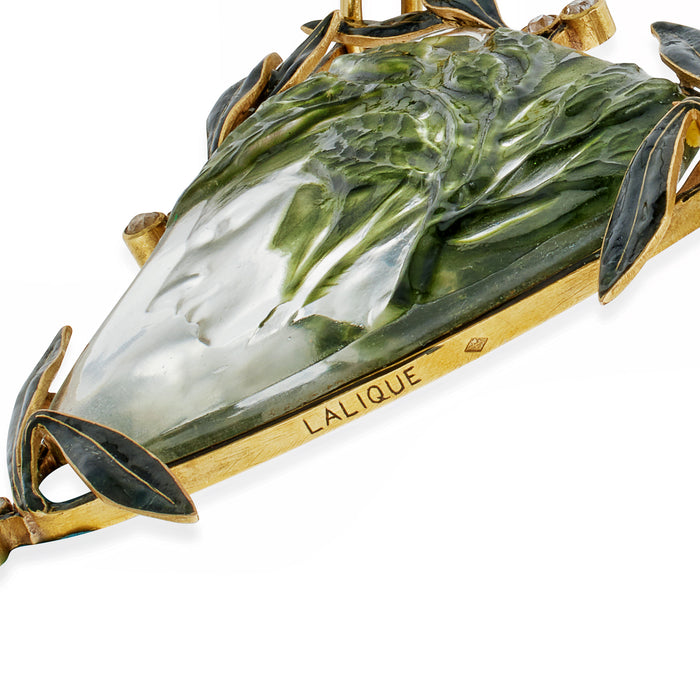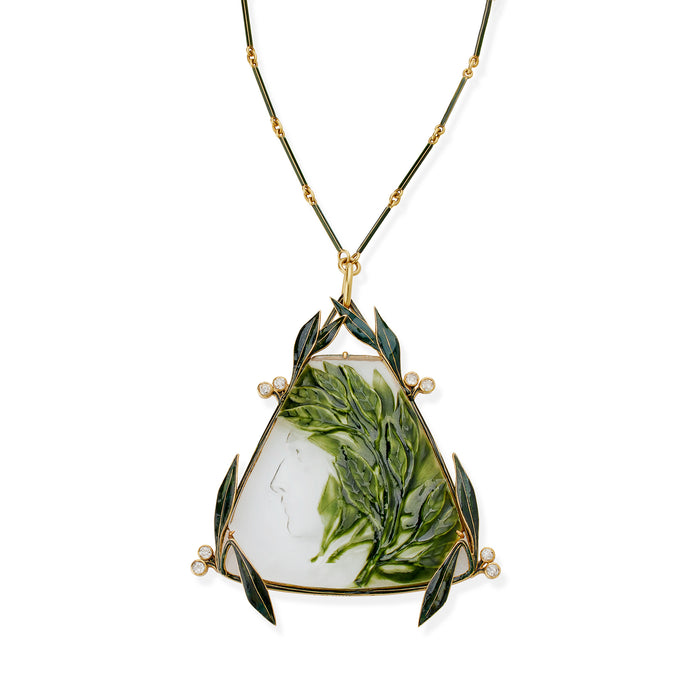
René Lalique Art Nouveau Crystal, Enamel and Diamond Pendant Necklace
$135,000
Created circa 1904-1905 by René Lalique, this Art Nouveau pendant necklace is composed of enamel on crystal glass, diamonds, and 18K gold. It is designed as transparent, colorless crystal plate cut with a relief image of an allegorical visage of peace or victory, surmounted by an overlay of green enamel laurel leaves with diamond berries, within a triangular 18K gold frame with champlevé enamel leaves and edges, suspended from baton link chain with conforming enamel. Increasingly interested in new forms and effects that could only be achieved in glass, Lalique confidently combined glass and diamonds, knowing that - in his hands - the glass would hold its own when juxtaposed with precious stones.
- Product Details
- Curator's Notes
Item #: N-21381
Artist: René Lalique
Country: France
Circa: 1904-1905
Dimensions: 2.25" length, 2.00" width.
Materials: 8 old mine-cut diamonds (approximate total weight 0.40 carat); Enamel on Glass; 18K Gold
Signed: LALIQUE, with poinçon of maker's mark
Exhibition History: Brussels Exhibition, 1965, no. 47, 18.
Literature: A jewel of this design is pictured in "René Lalique 1890-1910 Schmuck und Objets-d'Art", the catalogue raisonné by Sigrid Barten, p. 356, item 787. Further, an allegorical personification of "war", representing a similar visage framed by laurel, and dating from 1898-1900, is pictured in The Jewels of Lalique, Yvonne Brunhammer, ed., p.63.
According to Sigrid Barten, Lalique was already fascinated with glass as an art material by 1890. The unique properties of glass inspired him to constant experimentation in the medium. It allowed for the achievement of forms and effects impossible in other materials. Though a master of plique-à-jour enamel, Lalique began to feel that even that complex technique limited his freedom of expression due to the divisions in the image produced by the slim gold edges of the panels. He developed his own formula for jewelry glass, a sparkling "demi-crystal" that was very pliable and could be carved to a refined degree of definition on the wheel.
As inspiration for this work, Lalique studied the methods employed in the creation of Venetian enameled glass drinking vessels of the Quattro Cento. The cooled vessel was painted with enamel, which was then fused to the glass base by the brief application of a targeted flame, as here Lalique gave the laurel leaves an overlay of dark green matte enamel. Occasionally, Lalique collaborated with select outside craftsmen, but the presence of particular equipment (such as muff ovens) in Lalique's workshop indicates this enamel and glasswork were done in house.
Allegorical figures, represented by a beautiful, sometimes androgynous visage, appear several times in Lalique's oeuvre, from his design for an "allegory of war" - a similar face transformed by rage, framed by fruiting laurel boughs and snakes- to his enamel pendant featuring a gold and polychrome enamel personification of Autumn trailing a cascade of falling leaves. Here, Lalique may have used the figure with fruiting laurel branches as the Greek and Roman symbol of victory and success. Emphasizing the laurel through the application of the overlay of dark green enamel underscores the importance of the victory itself, while any sense of the individual behind it fades into the transparency of the glass.
A crystal, diamond and enamel jewel of similar overall design (accession no. 44.123.1) is held in the collection of the Museum of Art (MMA). This jewel represents an alternate, more complex glass technique versus that held by the MMA, where the crystal plate is engraved with lilac blossoms.

